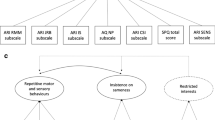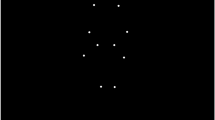Abstract
Autism and Asperger’s disorder (AD) are characterised by impairments in social interaction, stereotypic behaviours or restricted interests. Although currently listed as distinct clinical disorders, the validity of their distinction remains controversial. This study examined gait in children with autism and AD. Eleven children with high-functioning autism and eleven children with AD completed a series of walking tasks. Results indicated distinct movement disturbance; these findings are discussed in light of seminal papers in this field by Vilensky et al. (Arch Neurol 38:646–649, 1981) and Hallett et al. (Arch Neurol 50:1304–1308, 1993) who interpret the gait of individuals with autism using parkinsonian and cerebellar-ataxia patient models, respectively. Distinctions in gait patterns implicating perhaps unique motor circuit disturbances support the hypothesis that autism and AD may have unique neurodevelopmental trajectories.

Similar content being viewed by others
References
Ambrosini, D., Courchesne, E., & Kaufman, K. (1998). Motion analysis of patients with infantile autism. Gait & Posture, 7, 188.
American Psychiatric Association. (1994). Diagnostic and statistical manual of mental disorders (4th ed.). Washington, DC: American Psychiatric Association.
American Psychiatric Association. (2002). Diagnostic and statistical manual of mental disorders (4th ed., text revision). Washington, DC: American Psychiatric Association.
Blin, O., Ferrandez, A. M., & Serratrice, G. (1990). Quantitative analysis of gait in Parkinson patients: Increased variability of stride length. Journal of Neurological Science, 98(1), 91–97.
Brasic, J. R., & Gianutsos, J. G. (2000). Neuromotor assessment and autistic disorder. Autism, 4(3), 287–298.
Damasio, A. R., & Maurer, R. G. (1978). A neurological model for childhood autism. Archives of Neurology, 35(12), 777–786.
Dowd, A., Rinehart, N., & McGinley, J. (2010). Motor function in children with autism: Why is this relevant to psychologists? Clinical Psychologist, 14(3), 90–96.
Ebersbach, G., Sojer, M., Valldeoriola, S. F., Wissel, J., Muller, J., Tolosa, E., et al. (1999). Comparative analysis of gait in Parkinson’s disease, cerebellar ataxia, and subcortical arteriosclerotic encephalopathy. Brain, 122, 1349–1355.
Gabell, A., & Nayak, U. S. (1984). The effect of age on variability in gait. Journal of Gerontology, 39, 662–666.
Hallett, M., Lebeidowska, M. K., Thomas, S. L., Stanhope, S. J., Denckla, M. B., & Rumsey, J. (1993). Locomotion of autistic adults. Archives of Neurology, 50, 1304–1308.
Hallett, M., & Massaquoi, S. (1993). Physiologic studies of dysmetria in patients with cerebellar deficits. Canadian Journal of Neurological Science, 20(S3), 83–89.
Hausdorff, J. M., Cudkowicz, M. E., Firtion, R., Wei, J. Y., & Goldberger, A. L. (1998). Gait variability and basal ganglia disorders: Stride-to-stride variations of gait cycle timing in Parkinson’s disease and Huntington’s disease. Movement Disorders, 13(3), 428–437.
Kanner, L. (1943). Autistic disturbances of affective contact. Nervous Child, 2, 217–250.
Kohen-Raz, R., Volkmar, F. R., & Cohen, D. J. (1992). Postural control in children with autism. Journal of Autism and Developmental Disorders, 22(3), 419–432.
Leary, M. R., & Hill, D. A. (1996). Moving on: Autism and movement disturbance. Mental Retardation, 34(1), 39–53.
Lord, C., Rutter, M., & Le Couteur, A. (1994). Autism diagnostic interview-revised: A revised version of a diagnostic interview for caregivers of individuals with possible pervasive developmental disorders. Journal of Autism and Developmental Disorders, 24, 659–685.
Lotspeich, L. J., Kwon, H., Schumann, C. M., Fryer, S. L., Goodlin-Jones, B. L., & Buonocore, M. H. (2004). Investigation of neuroanatomical differences between autism and Asperger syndrome. Archives of General Psychiatry, 61, 291–298.
Mari, M., Castiello, U., Marks, D., Marraffa, C., & Prior, M. (2003). The reach-to-grasp movement in children with autism spectrum disorder. Philosophical Transactions of the Royal Society of London B, 358, 393–403.
McAlonan, G., Suckling, J., Wong, N., Cheung, V., Lienenkaemper, N., Cheung, C., et al. (2008). Distinct patterns of grey matter abnormality in high-functioning autism and Asperger’s syndrome. The Journal of Child Psychology and Psychiatry, 49, 1287–1295.
Minshew, N., & Williams, D. (2007). The new neurobiology of autism: cortex, connectivity, and neuronal organization. Archives of Neurology, 64(7), 945–950.
Morris, M. E., Iansek, R., Matyas, T. A., & Summers, J. J. (1994). The pathogenesis of gait hypokinesia in Parkinson’s disease. Brain, 117, 1169–1181.
Mostofsky, S., Powell, S., Simmonds, D., Goldberg, M., Caffo, B., & Pekar, J. (2009). Decreased connectivity and cerebellar activity in autism during motor task performance. Brain, 132, 2413–2425.
Nayate, A., Bradshaw, J. L., & Rinehart, N. J. (2005). Autism and Asperger’s disorder: Are they movement disorders involving the cerebellum and/or basal ganglia? Brain Research Bulletin, 67, 327–334.
Palliyath, S., Hallett, M., Thomas, S. L., & Lebiedowska, M. K. (1998). Gait in patients with cerebellar ataxia. Movement Disorders, 13(6), 958–964.
Patla, A. E. (1996). Neurobiomechanical bases for the control of human locomotion. In A. M. Bronstein, T. Brandt, M. Woollacott, & A. E. Patla (Eds.), Clinical disorders of balance, posture, and gait (pp. 19–40). London: Arnold.
Rinehart, N. J., Bradshaw, J. L., Moss, S. A., Brereton, A. V., & Tonge, B. J. (2008). Brief report: Inhibition of return in young people with autism and Asperger’s disorder. Autism, 12(3), 249–260.
Rinehart, N. J., Tonge, B. J., Bradshaw, J. L., Iansek, R., Enticott, P. G., & Johnson, K. A. (2006a). Movement-related potentials in high-functioning autism and Asperger’s disorder. Developmental Medicine and Child Neurology, 48, 272–277.
Rinehart, N. J., Tonge, B. J., Bradshaw, J. L., Iansek, R., Enticott, P. G., & McGinley, J. (2006b). Gait function in high-functioning autism and Asperger’s disorder: Evidence for basal ganglia and cerebellar involvement? European Child and Adolescent Psychiatry, 15(5), 256–264.
Rinehart, N. J., Tonge, B. J., Iansek, R., McGinley, J., Brereton, A. V., Enticott, P. G., et al. (2006c). Gait function in newly diagnosed children with autism: cerebellar and basal ganglia related motor disorder. Developmental Medicine and Child Neurology, 48(10), 819–824.
Stolze, H., Klebe, S., Peterson, G., Raethjen, J., Wenzelburger, R., Witt, K., et al. (2002). Typical features of cerebellar ataxic gait. Journal of Neurology, Neurosurgery and Psychiatry, 73, 310–312.
Stolze, H., Kuhtz-Buschbeck, J. P., Drucke, H., Johnk, K., Illert, M., & Deuschl, G. (2001). Comparative analysis of the gait disorder of normal pressure hydrocephalus and Parkinson’s disease. Journal of Neurology, Neurosurgery and Psychiatry, 70, 289–297.
Sutherland, D. H., Olshen, R., Cooper, L., & Woo, S. L. (1980). The development of mature gait. The Journal of Bone and Joint Surgery, 62(3), 336–353.
Teitelbaum, O., Benton, T., Shah, P. K., Prince, A., Kelly, J. L., & Teitelbaum, P. (2004). Eshkol-Wachman movement notation in diagnosis: The early detection of Asperger’s syndrome. Proceedings of the National Academy of Sciences of the United States of America, 101(32), 11909–11914.
Teitelbaum, P., Teitelbaum, O., Nye, J., Fryman, J., & Maurer, R. G. (1998). Movement analysis in infancy may be useful for early diagnosis of autism. Proceedings of the National Academy of Sciences of the United States of America, 95(23), 13982–13987.
Terry, J. B., & Rosenberg, R. N. (1995). Frontal lobe ataxia. Surgical Neurology, 44(6), 583–588.
Vilensky, J. A., Damasio, A. R., & Maurer, R. G. (1981). Gait disturbances in patients with autistic behaviour. Archives of Neurology, 38, 646–649.
Wing, L. (1981). Asperger’s syndrome: A clinical account. Psychological Medicine, 11(1), 115–129.
Winter, D. A., & Eng, P. (1995). Kinetics: our window into the goals and strategies of the central nervous system. Behavioural Brain Research, 67, 111–120.
Acknowledgments
Many thanks to the parents and children from the Centre for Developmental Psychiatry and Psychology at Monash University, as well as all other parents and children who participated in this research.
Author information
Authors and Affiliations
Corresponding author
Rights and permissions
About this article
Cite this article
Nayate, A., Tonge, B.J., Bradshaw, J.L. et al. Differentiation of High-Functioning Autism and Asperger’s Disorder Based on Neuromotor Behaviour. J Autism Dev Disord 42, 707–717 (2012). https://doi.org/10.1007/s10803-011-1299-5
Published:
Issue Date:
DOI: https://doi.org/10.1007/s10803-011-1299-5




